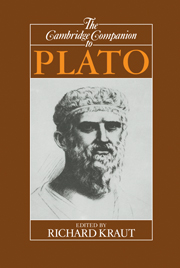Book contents
- Frontmatter
- 1 Introduction to the study of Plato
- 2 Plato
- 3 Stylometry and chronology
- 4 Socrates and the early dialogues
- 5 Mathematical method and philosophical truth
- 6 Inquiry in the Meno
- 7 Plato and Greek religion
- 8 Platonic love
- 9 Plato's metaphysical epistemology
- 10 The defense of justice in Plato's Republic
- 11 Plato on poetic creativity
- 12 Good-bye to the Third Man
- 13 Plato's Sophist on false statements
- 14 Disintegration and restoration
- 15 Plato's later political thought
- Bibliography
- Index
13 - Plato's Sophist on false statements
Published online by Cambridge University Press: 28 May 2006
- Frontmatter
- 1 Introduction to the study of Plato
- 2 Plato
- 3 Stylometry and chronology
- 4 Socrates and the early dialogues
- 5 Mathematical method and philosophical truth
- 6 Inquiry in the Meno
- 7 Plato and Greek religion
- 8 Platonic love
- 9 Plato's metaphysical epistemology
- 10 The defense of justice in Plato's Republic
- 11 Plato on poetic creativity
- 12 Good-bye to the Third Man
- 13 Plato's Sophist on false statements
- 14 Disintegration and restoration
- 15 Plato's later political thought
- Bibliography
- Index
Summary
In Plato's dialogue the Sophist, the main interlocutors, the Eleatic Stranger and Theaetetus, are trying to determine the nature of the sophist. Given that the phenomenon of the sophistic movement is so many-faceted and somewhat amorphous, it is not surprising that the first attempts in the dialogue to get a grip on the elusive reality underlying this phenomenon turn out to be not particularly successful, since they at best capture some superficial feature of the sophist. These features are recapitulated at 231c8-e7. Then, in 232a1ff a renewed attempt is made to capture the sophist; this attempt seems to go more to the heart of the matter, but runs into difficulties whose resolution occupies the remainder of the dialogue. The suggestion is that the sophist has a remarkable ability to represent things in a way that makes this representation, the sophist's statement about things, appear and seem to be true, though, in fact, it is not. This raises a series of difficulties, first alluded to in 235d2, then again in 236c9ff, and spelled out in considerable detail in 236d9ff.
- Type
- Chapter
- Information
- The Cambridge Companion to Plato , pp. 397 - 424Publisher: Cambridge University PressPrint publication year: 1992
- 96
- Cited by

